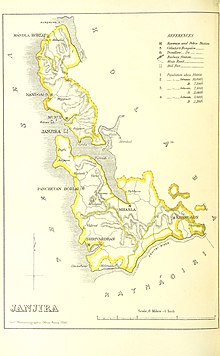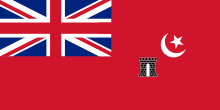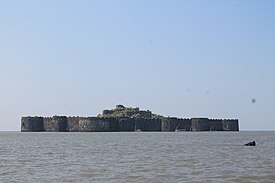Janjira State
| Janjira State जंजीरा रियासत | |||||||
|---|---|---|---|---|---|---|---|
British India (1759–1948)In union with Jafrabad | |||||||
| 1489–1948 | |||||||
|
Flag | |||||||
 Janjira State, 1896 | |||||||
| Area | |||||||
• 1931 | 839 km2 (324 sq mi) | ||||||
| Population | |||||||
• 1931 | 110,389 | ||||||
| History | |||||||
• Established | 1489 | ||||||
| 1948 | |||||||
| |||||||
| Today part of | Maharashtra, India | ||||||


Janjira State was a
Janjira State was located on the
History
Establishment
According to one legend, in the year 1489 the Ahmadnagar Sultanate sent its Admiral Piram Khan (of Ethiopian descent) with orders to capture the Murud-Janjira from Ram Patil. Owing to the castle's fortifications, the Admiral could not attack conventionally.
He and his team disguised themselves as merchants and asked Ram Patil to safeguard their three hundred large boxes containing silks and wines from Surat. As thanks, Piram Khan threw a party with wine. Once Ram Patil and his soldiers were intoxicated, Piram Khan opened the boxes, which contained his soldiers, and used the opportunity to capture the castle and the island on which it stands.[2][3][4][5][6][7]
In the century that followed the rulers put themselves under the overlordship of the
Cooperation with the Ottomans
According to Ottoman records, a combined force from the Ottomans and Janjira mariners routed a Portuguese fleet in 1587 at Yemen.[8] From this moment onwards Janjira played an important role in resisting Portuguese influence in the region.[9]
There's further record of Cooperation with the
Cooperation with the Mughals
According to one records at one time
Another record from an
Relations with the Marathas
Rivalry with the Marathas
The main competitor of the Sidis was the Angrias, a Maratha family with sea forts and ships, based in southern Konkan.[13]
Treaty with Marathas
In 1733,
Post Maratha-rule
When the British came to the Konkan area, the repeated attacks of the Marathas against Janjira ceased. Janjira State was administered as part of the Deccan States Agency of the Bombay Presidency, founded in 1799. In the nineteenth century the rulers maintained a military force of 123 men.[15]
Following the
Rulers
The royal family of Janjira were
Wazirs of Janjira
- Siddi Fattekhan
- 1676 - 1703 Kasim Yakut Khan II (d. 1703)
- 1703 - 1707 Amabat Yaqut Khan II
- 1707 - 1732 Surur Yakut Khan II (d. 1732)
- 1732 - 1734 Hasan Khan (1st time) (d. 1746)
- 1734 - 1737 Sumbul Khan
- 1737 - 1740 `Abd al-Rahman Khan
- 1740 - 1745 Hasan Khan (2nd time) (s.a.)
- 1745 - 1757 Ibrahim Khan I (1st time) (d. 1761)
- 1757 Mohammad Khan I (d. 1757)
- 1757 - 1759 Ibrahim Khan I (2nd time) (s.a.)
Thanadars of Jafarabad and Wazirs of Janjira
- 1759 - 1761 Ibrahim Khan I (s.a.)
- 1761 - 1772 Yaqut Khan (usurper to 6 Jun 1772) (d. 1772)
- 1772 - 1784 `Abd al-Rahim Khan (d. 1784)
- 1784 - 1789 Jauhar Khan (d. 1789)
- - in dispute with -
- 1784 - 1789 `Abd al-Karim Yaqut Khan
- - in dispute with -
- 1789 - 1794 Ibrahim Khan II (d. 1826)
- 1794 - 1803 Jumrud Khan (d. 1803)
Nawabs
- 1803 - 1826 Ibrahim Khan II (s.a.)
- 1826 - 31 Aug 1848 Mohammad Khan I (d. 1848)
- 31 Aug 1848 – 28 Jan 1879 Ibrahim Khan III (b. 1825 - d. 1879)
- 28 Jan 1879 - 2 May 1922 Ahmad Khan (b. 1862 - d. 1922) (from 1 Jan 1895, Sir Ahmad Khan)
- 28 Jun 1879 – 11 Oct 1883 .... -Regent
- 2 May 1922 – 15 Aug 1947 Mohammad Khan II (b. 1914 - d. 1972)
- 2 May 1922 - 9 Nov 1933 Kulsum Begum (f) -Regent (b. 1897 - d. 1959)[18]
See also
- Jafarabad State
- Murud-Janjira
- Sachin State
- Anjanvel
- Political integration of India
- Deccan States Agency
References
- ^ a b Chisholm, Hugh, ed. (1911). . Encyclopædia Britannica. Vol. 15 (11th ed.). Cambridge University Press. p. 152.
- ISBN 9783865372062.
- ^ Gazetteer of the Bombay Presidency: Kola'ba and Janjira. Government Central Press. 1883.
- ISBN 9788188204731.
- ISBN 9788125004851.
- ISBN 9780865439801.
- ISBN 9782765903611.
- ISBN 9788120843011. Retrieved 5 June 2023.
- ^ Ottoman court chroniclers (1588). Muhimme Defterleri, Vol. 62 f 205 firman 457, Avail Rabiulavval 996.
- ^ Cambridge illustrated atlas, warfare: Renaissance to revolution, 1492–1792 by Jeremy Black p.17 [1]
- ISBN 8125004858.
- ISBN 9781136790874. Retrieved 8 November 2015.
- ^ OCLC 25914184.
- ISBN 978-1-932705-54-6.
- ^ Great Britain India Office. The Imperial Gazetteer of India. Oxford: Clarendon Press, 1908
- ^ "Janjira Princely State (11 gun salute)". Archived from the original on 21 July 2018. Retrieved 11 July 2014.
- ^ "The Durbar Honours". The Times. No. 36966. London. 1 January 1903. p. 8.
- ^ Princely States of India
External links
 Media related to Janjira State at Wikimedia Commons
Media related to Janjira State at Wikimedia Commons- Janjira State coat of arms
- A Trip to Murud Janjira Fort

